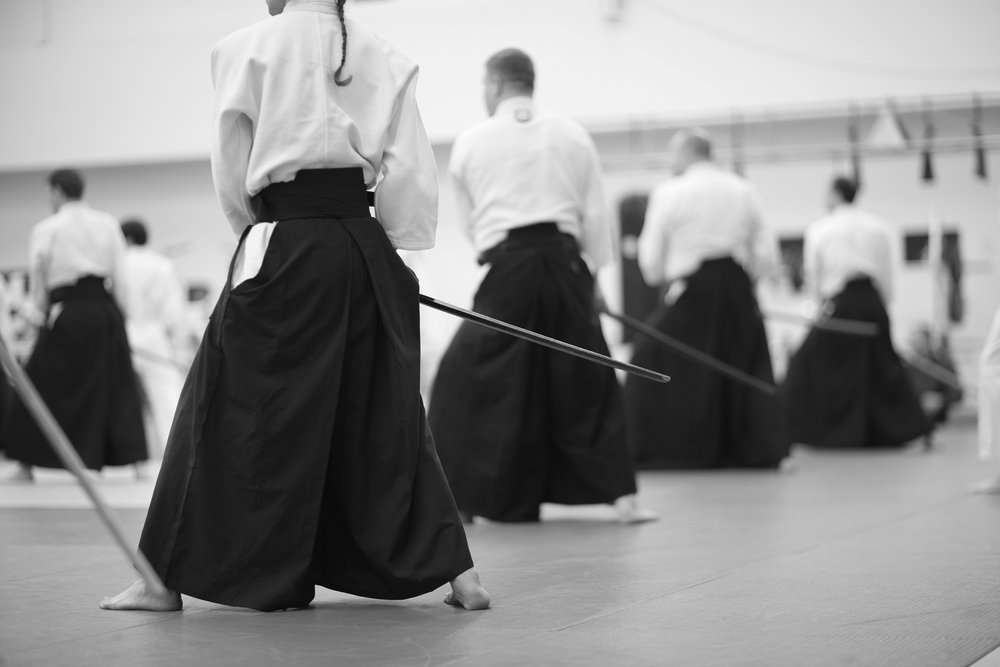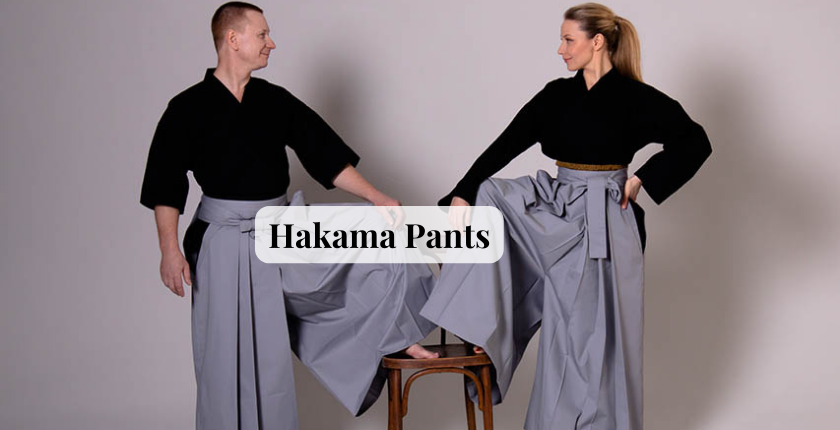Table of Contents
Hakama is a traditional Japanese garment that holds a significant place in Japanese culture and history. It is a type of wide-legged trouser or skirt, typically worn over a kimono. While commonly associated with martial arts practitioners and formal ceremonies, hakama has a rich history and diverse usage beyond its stereotypical image.
In this article, we will delve into the fascinating world of hakama, exploring its origins, symbolism, modern adaptations, and more.
History of Hakama

Origins
The history of hakama can be traced back to ancient Japan, where it was initially worn by the nobility and samurai class. The garment served practical purposes, such as providing ease of movement while riding horses and symbolizing social status. Early hakama were crafted from luxurious fabrics and adorned with intricate designs, reflecting the wearer’s rank and prestige.
Evolution over time
As Japan underwent periods of cultural and societal change, the style and significance of hakama evolved accordingly. During the Edo period (1603-1868), hakama became more standardized in design and were worn by a broader spectrum of society, including scholars, artisans, and merchants. The garment also underwent modifications to suit various occasions and professions, leading to the development of different types and styles.
Types of Hakama
Hakama comes in various forms, each tailored for specific purposes and occasions.
Formal Hakama
Formal hakama, known as “ōkamishita,” are typically worn during ceremonial events such as weddings, funerals, and tea ceremonies. They are characterized by their elegant design, often featuring rich colors and intricate patterns. Formal hakama are meticulously folded and tied in a specific manner, adhering to traditional customs and etiquette.
Casual Hakama
Casual hakama, or “koukamishita,” are more relaxed in style and are often worn for everyday activities or informal gatherings. They are made from lighter fabrics and may feature simpler designs, offering greater comfort and versatility for the wearer. Casual hakama are popular among modern individuals seeking to incorporate elements of Japanese tradition into their daily attire.
What’s the Difference Between a Hakama and a kimono?
| Feature | Hakama | Kimono |
|---|---|---|
| Function | Skirt-like pants | Long robe |
| Formality | Can be formal or informal | Primarily formal |
| Gender | Traditionally worn by men, now by both | Primarily worn by women |
| Wearing Style | Worn with a koshiita (stiff back piece) and tied with himo (strings) | Worn with an obi (sash) to secure it around the waist |
Components of Hakama
Hakama consists of several components that contribute to their distinctive appearance and functionality.
Fabric
Traditionally, hakama are crafted from high-quality fabrics such as silk, cotton, or linen, chosen for their durability and aesthetic appeal. The choice of fabric can vary depending on the intended use of the hakama, with formal garments typically made from luxurious materials and casual ones from more lightweight options.
Design and structure
Wide-legged silhouettes and pleated construction, which promote airflow and ease of movement, are characteristics of hakama. The “hakama-eri,” or pleats, are a succession of skillfully placed and stitched pleats that give the garment its characteristic shape. Furthermore, hakama are fastened at the waist by a belt or tie, guaranteeing a form-fitting but comfortable fit for the user.
How to Wear Hakama
Wearing hakama involves a precise and methodical process to achieve the desired appearance and functionality.
Step-by-step guide
- Start by putting on the kimono or traditional Japanese attire.
- Fold the hakama in half lengthwise, with the pleats facing outward.
- Wrap the folded hakama around your waist, ensuring that the front panel is slightly longer than the back.
- Tie the hakama securely at the waist using the provided ties or a decorative belt.
- Adjust the length and drape of the hakama to your preference, ensuring that it falls gracefully over the kimono.
- Complete the ensemble with appropriate footwear, such as tabi socks and zori sandals, to complement the hakama.
Symbolism and Cultural Significance
Hakama holds deep symbolism and cultural significance in Japanese society, representing tradition, honor, and reverence.
Traditional roles and occasions
Throughout history, hakama have been worn during various ceremonial rituals and rites of passage, symbolizing the transition from one stage of life to another. They are often associated with milestones such as coming-of-age ceremonies, weddings, and funerals, where they serve as a visual marker of respect and solemnity.
Spiritual symbolism
In some cultural contexts, hakama have spiritual value in addition to their utilitarian use. The flowing silhouette of the hakama is seen in Buddhist and Shinto traditions as a symbol of the cosmos’ interconnectivity and spiritual enlightenment. Priests and other religious practitioners occasionally wear them during rites and rituals because of this.
Read also: Nebraskawut Cappello
Why do they wear a Hakama in Aikido?
| Reason | Description |
|---|---|
| Tradition | Connects to samurai heritage |
| Symbolism | Represents Bushido virtues |
| Practicality | Offers freedom of movement, hides techniques (somewhat) |
| Rank (Some schools) | Color indicates experience level |
Modern Adaptations and Trends
While rooted in tradition, hakama has also experienced adaptations and innovations to suit contemporary tastes and lifestyles.
Fashion industry influence
Hakama has become more and more popular outside of traditional circles in recent years, partly due to the influence of the fashion industry. To appeal to a wider audience, designers and manufacturers have reimagined the classic garment by combining contemporary fabrics, colors, and patterns. Hakama has thereby bridged the gap between tradition and innovation by becoming a mainstay in both streetwear and haute couture.
Contemporary usage
Today, hakama are worn not only on special occasions but also as everyday attire by individuals seeking to embrace their cultural heritage. They are often paired with casual tops, jackets, or even T-shirts, creating a fusion of traditional and modern styles. Additionally, hakama are favored by practitioners of martial arts such as kendo, aikido, and kyudo, where they serve both practical and symbolic purposes.
Iconic Figures and Hakama
Throughout history, numerous iconic figures have been associated with hakama, further cementing its status as a symbol of honor and prestige.
Famous personalities associated with Hakama
Many people in a variety of professions and fields have worn hakama, from famous samurai warriors to contemporary cultural icons. Aikido creator Morihei Ueshiba and famed swordsman Miyamoto Musashi are only two examples of people who have worn traditional clothing with dignity and grace.
Hakama in Martial Arts
Hakama play a prominent role in various martial arts disciplines, where they serve both practical and symbolic functions.
Historical context
Historically, hakama were worn by samurai warriors as part of their armor, providing protection and freedom of movement on the battlefield. Over time, the garment became associated with martial prowess and discipline, leading to its adoption by practitioners of traditional Japanese martial arts.
Functionality in different disciplines
In martial arts such as kendo, judo, and kyudo, hakama is worn as a symbol of rank and proficiency, with different colors and styles denoting various levels of expertise. They also serve a practical purpose by concealing the movement of the legs and feet, making it more challenging for opponents to anticipate strikes or maneuvers.
Can You Wear a Kimono With a Hakama?
Yes, you can wear a kimono with a hakama. The hakama is traditionally worn over a kimono for formal occasions, adding a ceremonial touch to the outfit. The hakama is a wide-legged trouser-like garment that complements the kimono, especially for events like tea ceremonies, weddings, and martial arts practices
Preservation of Hakama Tradition
Despite the passage of time, efforts are underway to preserve and promote the tradition of hakama in modern society.
Efforts to maintain cultural heritage
Organizations and institutions dedicated to Japanese culture and heritage play a vital role in safeguarding the legacy of hakama. Through educational programs, exhibitions, and workshops, they seek to impart knowledge and appreciation for traditional garments like hakama, ensuring that they remain relevant for future generations.
Challenges and prospects
However, the proliferation of Western fashion and lifestyle trends poses challenges to the continued relevance of hakama in contemporary society. As younger generations embrace globalized influences, there is a risk of traditional garments like hakama being overshadowed or forgotten. Nevertheless, advocates of cultural preservation remain optimistic about the enduring appeal of hakama and its ability to adapt to changing times.
Global Influence and Adoption
In recent years, hakama have transcended cultural boundaries, gaining recognition and appreciation on a global scale.
Hakama beyond Japan
With the rise of globalization and cross-cultural exchange, hakama have found their way into fashion runways, film productions, and cosplay events worldwide. Enthusiasts from diverse backgrounds are drawn to the elegance and sophistication of hakama, incorporating them into their unique styles and expressions.
Cultural appreciation and appropriation
While the growing popularity of hakama is a testament to its universal appeal, there are concerns about cultural appropriation and misrepresentation. It is essential to approach the wearing of hakama with respect and understanding of its cultural significance, acknowledging its roots in Japanese tradition and history.
Final Words
Final Words explains that hakama is more than just a garment; they are an embodiment of centuries’ worth of custom, artistry, and cultural legacy. Hakamas have fascinated and inspired people all over the world from their modest origins as samurai uniforms and have continued to do so in the fashion and martial arts industries today. We commemorate the ongoing spirit of invention and adaptation as well as Japan’s rich cultural tradition by respecting and maintaining the hakama legacy.




